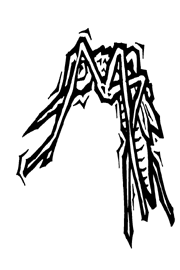 |
 |
 |
 |
 |
 |
David discovers how satellite technology helps prevent disease.
Segment Length: 7:30
Malaria Tracking
Show Number 1410
How can you locate
disease-carrying mosquitoes?
When are mosquitoes dangerous?
Why do female mosquitoes suck blood?
![]() Getting Started
Getting Started
Why do mosquitoes bite? Do all mosquitoes bite? How can mosquitoes spread disease? What diseases can mosquitoes carry?
How can we prevent mosquito-borne diseases? How can we use technology to control mosquitoes?
Mosquitoes aren't just irritating. They can carry diseases like malaria, a huge problem for people who live in the tropics where mosquitoes breed year-round. Malaria endangers the lives of millions worldwide, and the numbers are increasing.
Malaria is caused by a parasite that infects mosquitoes in the genus Anopheles. Both male and female mosquitoes feed on plant nectar, but females of most kinds of mosquitoes need a blood meal for protein so their bodies can make eggs. Anyone bitten by an infected female anopheles can also be infected with the malaria parasite.
One way to stop malaria and other diseases carried by mosquitoes is to eliminate the mosquitoes themselves. But many kinds of mosquitoes have become resistant to chemicals that have been used to get rid of them. New techniques are needed. For example, scientists have stocked mosquito fish in storm water ponds along highways as a biological control. This small, minnow-type fish consumes hundreds of mosquito larvae per day.
Eliminating the places where mosquitoes breed works well when it is possible. But it's tough for people to locate anopheles mosquito breeding sites in deep, dense rain forests. That's where using satellites can help. Satellites that gather information through a technique called remote sensing help track the breeding sites of anopheles mosquitoes.Things on the ground, such as vegetation cover, standing pools of water, or human settlements, emit electromagnetic radiation. This radiation shows up as certain colors when picked up by infrared cameras aboard satellites. When fed into a computerized information base called a Geographic Information System (GIS), these remotely sensed images can be useful in interpreting what is happening on the ground. Infrared cameras are used because they reveal more information than can be obtained from images taken with visible light. Heat characteristics of objects can be observed during night and day with infrared cameras.
A GIS uses the power of the computer to help answer geographic questions by arranging and displaying useful information about places in maps, charts, or tables. When ground events or situations can be correlated with data sent from remote satellites, experts will be able to predict ground conditions from satellite data. This correlation is done though a process called ground truthing, or finding out through field studies how satellite images correspond to what is actually happening on the ground. When experts know the kind of vegetation anopheles mosquitoes prefer to feed on, and if they can see from satellite images where it is growing, they can plan and monitor long-term campaigns for the control of malaria.
American Mosquito Control Association, Inc.
2200 East Prien Lake Road
Lake Charles, LA 70601
(318) 474-2723Carolina Biological Supply Company
2700 York Road
Burlington, NC 27215
(800) 334-5551
(Mosquito life-cycle kit or mosquito larvae)Environmental Systems Research Institute, Inc.
380 York St
Redlands, CA 92373-8100
(909) 793-2849Metropolitan Mosquito Control District
2099 University Ave W.
St. Paul, MN 55104-3431
(612) 645-9149National Center for Geographic Information and Analysis (NCGIA)
U.C. at Santa Barbara
Santa Barbara, CA 93106-4060
(805) 893-4305NASA classroom of the future:
http://www.cotf.edu/ETE/scen/rainforest/RemoteSensing.htmlRemote sensing:
http://www.rsgis.do.usbr.gov/
Student Activity:
Malaria Tracking

Mosquito Patrol
Devise a plan to help prevent mosquito-borne diseases.
Malaria is not the problem it once was in the United States, but container-type mosquitoes - those that lay eggs anyplace they find still or slow-moving water - are a national problem. For example, the tree hole mosquito carries LaCrosse encephalitis, a viral disease that can affect children under age 18. Tree hole mosquitoes breed and develop in water-holding tree holes and artificial containers such as old tires, cans, buckets, and children's toys. This differs from the pest mosquitoes that use temporary pools of water (marshes and land depressions) for a breeding habitat. Very few tree hole mosquitoes in any area actually carry the virus, but children can become ill if they are bitten by one that does. If tree hole mosquito breeding sites are modified or removed from an area, then no adult tree hole mosquitoes are produced, and the LaCrosse virus cannot be transmitted to children.
Note: This activity is best suited for spring, summer, or early fall.
1. Brainstorm a list of places where mosquitoes breed.
2. Go on a mosquito patrol at home and school to identify and eliminate
possible mosquito
breeding sites. Report what you did to eliminate the site for breeding.
3. Create a leaflet to distribute in your neighborhood or community
and spread the word:
"Don't raise mosquitoes!"
Questions
![]()
Order disease-free mosquito larvae (see Resources) and watch the life cycle
of the mosquito unfold in your classroom. How does knowing the life cycle
help in efforts to control the mosquito and the diseases it carries to
people and pets?
![]()
Imagine you are preparing to travel to a tropical country. The Centers
for Disease Control and Prevention provide up-to-date information about
health concerns in other nations. List your questions and call
(404) 332-4559 or (404) 332-4555 for answers.
![]()
Find out what attracts mosquitoes to people. Combine those facts with what
you know about mosquito breeding sites to design an imaginary product to
repel mosquitoes. Prepare an "infomercial" to promote your product
and to help people avoid mosquito bites. Perform your infomercial complete
with sound effects.
Tapes of this episode of Newton's Apple and others are available
from GPN for only $24.95.
Please call 1-800-228-4630.
For information on other Newton's Apple resources for home and school,
please call 1-800-588-NEWTON!
 We encourage duplication for educational non-commercial use.
We encourage duplication for educational non-commercial use.